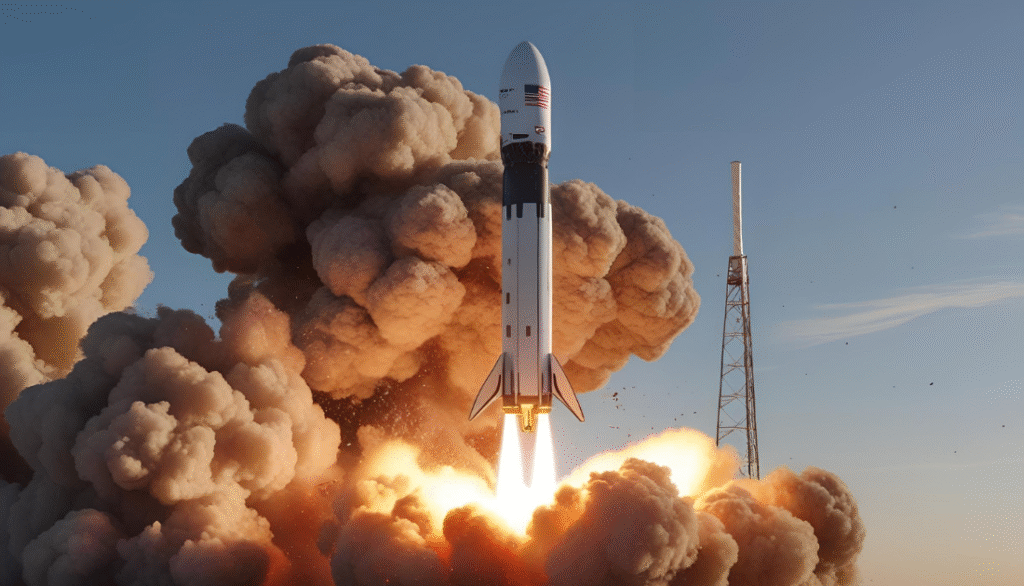An explosion during a ground test at SpaceX’s Starbase facility in Boca Chica, Texas, destroyed a Starship rocket late Wednesday night.
Highlights
- Major Explosion, No Injuries: A SpaceX Starship rocket exploded during a static fire test at Starbase, Texas, at 11:00 PM local time—fortunately, with no injuries reported.
- Suspected Cause: SpaceX attributed the blast to a likely failure in a nitrogen-filled Composite Overwrapped Pressure Vessel (COPV) in the rocket’s nosecone—a first for Starship prototypes.
- Prototype Lost: The rocket, meant for its 10th test flight, was destroyed. However, SpaceX CEO Elon Musk dismissed the loss as “a scratch,” consistent with the company’s risk-tolerant test-and-iterate approach.
- Massive Fireball and Shockwaves: The explosion caused shockwaves that rattled nearby towns, sent debris thousands of feet into the air, and ignited secondary fires, some of which burned into the morning.
- Environmental and Community Concerns: The incident reignited criticism from locals and environmental groups over ecological risks, fire hazards, and the impact on nearby wildlife areas.
- FAA and NASA Still Supportive: Despite the explosion, the FAA recently approved 25 annual Starship launches, and NASA continues backing Starship as a key vehicle for future Artemis lunar missions.
- Iterative Development Philosophy: SpaceX remains committed to rapid innovation through testing—even with explosive setbacks—as it pursues goals like Mars colonization and deep space transport.
- Investigation Ongoing: Engineers are reviewing telemetry and physical evidence to determine the exact cause, with future test flights likely to be rescheduled after analysis and fixes.
The blast occurred around 11:00 PM local time during a routine static fire test and generated a massive fireball visible across the night sky. Fortunately, no injuries were reported.
According to SpaceX, the area had been secured prior to the test, all personnel were safe, and the resulting fire was quickly contained.
Pressurized Tank Failure
SpaceX attributed the incident to what it described as “a sudden energetic event,” likely originating from a Composite Overwrapped Pressure Vessel (COPV) in the rocket’s nosecone.
COPVs are high-pressure tanks used to store gases such as nitrogen or helium. Initial analysis suggests the failure occurred in a nitrogen-filled tank—a first for the Starship program.
The company emphasized that the COPVs used in Starship are not the same as those in its Falcon rocket series, which have not experienced similar failures. However, the cause is still under investigation.
Complete Vehicle Loss, But No Program Halt
The vehicle destroyed in the explosion was a prototype from SpaceX’s next-generation Starship system—a fully reusable rocket designed to transport up to 150 metric tonnes to orbit.
Standing at 403 feet, Starship is the largest and most powerful launch system ever constructed and central to Elon Musk’s vision for crewed missions to the Moon, Mars, and beyond.
SpaceX CEO Elon Musk responded to the event publicly, calling the incident “a scratch,” despite the total vehicle loss.
The rocket had been preparing for what would have been its 10th test flight. While dramatic, the event aligns with SpaceX’s iterative development philosophy that embraces risk as a means to rapid innovation.
Fireball, Shockwaves, and Debris
The explosion occurred just 15 minutes before the scheduled test firing and caused a shockwave that rattled homes in nearby areas, including Brownsville and South Padre Island.
Windows reportedly bowed under the pressure, and debris was seen shooting thousands of feet into the air. Some fragments were found across the Rio Grande, and radar picked up extensive debris spread.
Brownsville fire crews assisted in containing secondary fires caused by the explosion, which continued to burn into the early morning hours.
Community Concerns and Environmental Scrutiny
The incident reignited concerns from local residents and environmental advocacy groups, who have previously raised alarms about the impact of frequent Starbase tests.
Complaints have centered on noise pollution, fire hazards, and ecological disruption—particularly affecting coastal wildlife near the launch site.
Critics argue that SpaceX’s rapid development pace has outstripped the region’s environmental capacity, and have called for stricter oversight from both state and federal regulators.
Regulatory Support Remains Strong
Despite the ongoing concerns, regulatory bodies continue to back the Starship program. Just days prior to the incident, the Federal Aviation Administration (FAA) granted approval for up to 25 Starship launches per year.
NASA, a key SpaceX partner, also remains committed to the program, citing Starship’s potential role in future deep space missions, including lunar landings as part of the Artemis program.
The agency continues to support the platform alongside SpaceX’s operational Dragon spacecraft, which currently transports astronauts to the International Space Station.
For SpaceX, setbacks like these are part of a broader strategy of high-frequency testing, learning, and iteration.


